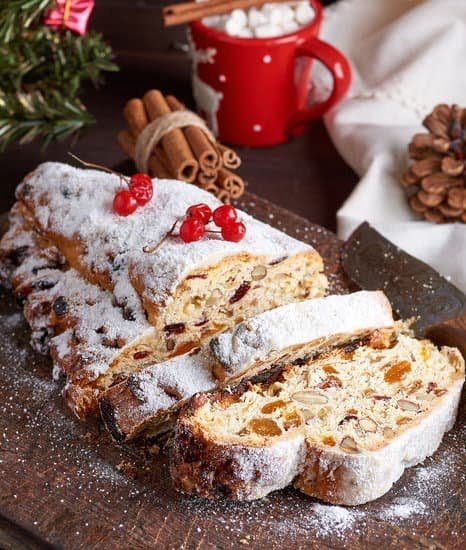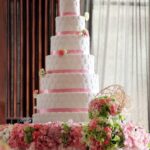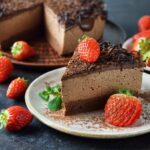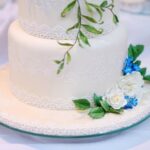Are you wondering, “Can I use whipped cream to decorate a cake?” Whipped cream is a versatile and popular choice for cake decoration, known for its light and creamy texture. In this article, we will explore the various ways whipped cream can be used to adorn cakes, from simple designs to intricate patterns. Whether you’re a baking enthusiast or a professional pastry chef, whipped cream offers endless possibilities for creative cake decorating.
Whipped cream has been a longstanding favorite for decorating cakes due to its delicious taste and ability to hold intricate designs. Its light and airy texture makes it perfect for creating fluffy borders, smooth finishes, and decorative swirls on cakes. Additionally, the versatility of whipped cream allows for both simple and elaborate designs, making it suitable for any occasion – from birthday celebrations to elegant weddings.
In the following sections, we will delve into the pros and cons of using whipped cream as a cake decoration, offering tips on preparing and using whipped cream effectively. We will also explore alternative decorating techniques using whipped cream, flavored and colored whipped cream options, troubleshooting common issues with whipped cream decorations, and the best types of cakes that complement whipped cream adornments.
Embracing the creative versatility of whipped cream in cake decorating opens up a world of possibilities for stunning and delectable creations.
The Pros and Cons of Using Whipped Cream to Decorate a Cake
Using whipped cream as a cake decoration has become increasingly popular in the world of baking and pastry arts. The light and creamy texture of whipped cream offers a delicate and delicious addition to any cake, making it a versatile option for decorating. However, there are both advantages and potential drawbacks to consider when using whipped cream as a cake decoration.
One of the main advantages of using whipped cream to decorate a cake is its ability to hold intricate designs. From simple swirls to elaborate rosettes and borders, whipped cream can be piped into various shapes and patterns with ease, allowing for endless creative possibilities. Additionally, the taste of whipped cream is beloved by many, adding a delightful flavor profile to complement the cake itself.
On the other hand, there are some potential drawbacks to using whipped cream as a cake decoration. One issue to consider is its tendency to melt in warm temperatures. This can be problematic, especially if the cake needs to be displayed or served in a warmer environment. Another consideration is the limited shelf life of whipped cream decorations, as they may not hold up well over an extended period of time.
Despite these potential drawbacks, with proper preparation and technique, using whipped cream as a cake decoration can result in stunning and delicious creations. By understanding both the pros and cons of this decorating method, bakers can make informed decisions about utilizing whipped cream in their cake designs.
Tips for Using Whipped Cream as a Cake Decoration
When it comes to using whipped cream as a cake decoration, there are several important tips and techniques to keep in mind in order to achieve the best results. Whether you are a beginner or an experienced baker, understanding how to work with whipped cream will ensure that your cake decorations turn out beautifully.
To start, it’s crucial to use cold heavy cream when making whipped cream for cake decoration. The colder the cream, the better it will whip up and hold its shape when decorating the cake. Additionally, make sure your tools and mixing bowl are also cold to help the whipped cream firm up more quickly.
In terms of achieving the perfect consistency for decorating, be mindful not to over-whip the cream. Over-whipping can lead to a grainy texture and even butter forming, which may not be ideal for decorating purposes. Aim for soft peaks that hold their shape but still have a light and fluffy texture. Adding a stabilizer such as gelatin or cornstarch can also help maintain the whipped cream’s shape and prevent it from deflating.
When storing or transporting cakes decorated with whipped cream, it’s important to keep them refrigerated until ready to serve. Whipped cream has a tendency to melt at room temperature, especially in warm weather, so it’s best to keep the cake cool until it’s time to be enjoyed. By following these tips, you can effectively use whipped cream as a delightful and versatile cake decoration option.
Alternative Decorating Techniques Using Whipped Cream
Whipped cream is a versatile and delicious option for decorating cakes, offering a light and creamy texture that can elevate the visual appeal of any dessert. While traditional piping techniques are commonly used with whipped cream to create decorative designs, there are also alternative methods that can add flair and creativity to cake decorations.
One alternative decorating technique using whipped cream involves the use of stencils. By placing a stencil over the surface of the cake, decorators can sprinkle cocoa powder or powdered sugar on top, creating intricate patterns or designs. This method adds an artistic touch to cakes and allows for personalized and unique decorations.
Another creative way to incorporate whipped cream into cake decorations is by using edible decorations in combination with piping techniques. Items such as fresh fruits, chocolate shavings, or edible flowers can be strategically placed on whipped cream frosted cakes to add color, texture, and visual interest. Piping around these elements with whipped cream can further enhance the overall design of the cake.
Furthermore, decorators can experiment with different shapes and forms when it comes to using whipped cream for cake decoration. Instead of traditional rosettes or swirls, consider creating small dollops across the surface of the cake in varying sizes, forming an abstract and modern pattern. This unconventional approach adds a contemporary touch to whipped cream decorated cakes.
Innovation and creativity are key when utilizing alternative techniques for whipped cream decorations. These methods offer decorators the opportunity to think outside the box and explore new ways to enhance their cake designs with this versatile ingredient.
| Alternative Decorating Techniques | Description |
|---|---|
| Stencil Decorations | Use stencils with cocoa powder or powdered sugar for intricate patterns |
| Edible Decorations & Piping | Incorporate fresh fruits, chocolate shavings, or edible flowers alongside piped whipped cream |
| Abstract Designs | Create modern patterns by experimenting with different shapes and forms |
Flavored and Colored Whipped Cream for Cake Decoration
Whipped cream is not only delicious, but it also offers a versatile canvas for adding different flavors and colors to elevate cake decorations. Here are some creative ways to enhance your whipped cream decorations:
- Flavored whipped cream: Adding a touch of flavor to your whipped cream can take your cake decorations to the next level. Consider using extracts like vanilla, almond, or lemon to infuse your whipped cream with delightful aromas. For an extra kick, you can also incorporate liqueurs such as Kahlua or Grand Marnier for a boozy twist.
- Colored whipped cream: While classic white whipped cream is elegant and timeless, adding color can make your cake decorations stand out. You can use food coloring gels or natural dyes from ingredients like matcha powder or fruit purees to achieve vibrant hues. Whether you want pastel shades for a whimsical look or bold colors for a festive occasion, colored whipped cream opens up endless possibilities for creative cake decorations.
- Creative examples: Experimenting with flavored and colored whipped cream can result in stunning cake decorations. Imagine a decadent chocolate cake adorned with mocha-flavored whipped cream swirls, or a vibrant rainbow-themed cake embellished with colorful whipped cream rosettes. The possibilities are truly endless when it comes to incorporating flavored and colored whipped cream into your cake decorating repertoire.
By infusing your whipped cream with unique flavors and vibrant colors, you can transform ordinary cakes into extraordinary works of art that delight the senses. Whether you’re creating a simple yet sophisticated dessert or an elaborate centerpiece for a special celebration, flavored and colored whipped cream can add an extra layer of creativity and visual appeal to your cake decorations.
So go ahead and explore the exciting world of flavored and colored whipped cream for endless inspiration in your cake decorating endeavors.
Creating Professional-Looking Whipped Cream Cake Decorations
When it comes to cake decorating, achieving a professional look is often the goal for many bakers. Using whipped cream as a cake decoration can certainly help in creating stunning and visually appealing designs. However, in order to achieve professional-looking whipped cream cake decorations, there are a few key tips and techniques that can make all the difference.
Smooth Finishes and Sharp Edges
One of the hallmarks of professional cake decorating is smooth finishes and sharp edges. When using whipped cream to decorate a cake, it’s important to pay attention to the consistency of the cream. By ensuring that the whipped cream is not too runny or too stiff, you can achieve a smooth finish on the surface of the cake. Additionally, using tools such as an offset spatula can help create sharp edges and clean lines for a polished appearance.
Practice and Patience
Creating professional-looking whipped cream decorations also requires practice and patience. Working with whipped cream can be delicate, so taking your time and practicing different techniques can lead to better results. It’s important to allow yourself room for error and understand that perfecting whipped cream decorations may take some time.
Attention to Detail
Another aspect of creating professional-looking whipped cream cake decorations is paying attention to detail. Whether you’re piping intricate designs or adding delicate touches to the cake, being mindful of small details can elevate the overall appearance of the decoration. Taking care with each design element will contribute to a more polished and professional result.
By incorporating these tips into your approach to using whipped cream as a cake decoration, you
Best Types of Cakes for Whipped Cream Decoration
When it comes to using whipped cream as a cake decoration, the type of cake you choose plays a crucial role in ensuring the success of your decoration. Certain cakes are better suited for holding whipped cream decorations due to their texture and ability to complement the light and creamy nature of whipped cream. Here, we’ll explore the best types of cakes for whipped cream decoration and why they work so well.
Soft and Moist Cakes
Soft and moist cakes, such as sponge cake and chiffon cake, are ideal for holding whipped cream decorations. Their tender crumb and airy texture provide a stable base for the whipped cream to adhere to without causing the cake to become soggy or dense. The lightness of these cakes complements the fluffy nature of whipped cream, creating a harmonious balance of textures in each bite.
Angel Food Cake
Angel food cake is another excellent option for whipped cream decorations. Its delicate structure pairs beautifully with the airy consistency of whipped cream, allowing for intricate designs and decorations without weighing down the cake. The subtle sweetness of angel food cake also pairs well with the light sweetness of whipped cream, creating a delightful flavor combination.
Pound Cake
For those who prefer a denser cake option, pound cake can also work well with whipped cream decorations. The sturdiness of pound cake provides a solid foundation for more elaborate whipped cream designs, making it suitable for special occasions or celebrations where a more substantial cake is desired. Additionally, the rich flavor of pound cake can complement a variety of flavored whipped creams, adding depth to your decorative creations.
Troubleshooting Common Issues With Whipped Cream Decorations
When it comes to using whipped cream as a cake decoration, there are a few common issues that may arise. Whether it’s instability, deflation, or other challenges, being prepared to troubleshoot these problems can help ensure successful whipped cream decorations on your cakes.
One common issue with using whipped cream as a cake decoration is its tendency to become unstable or deflate over time. This can be particularly problematic in warm temperatures or if the cake is not stored properly. To prevent this issue, it’s important to stabilize the whipped cream with ingredients such as gelatin or cornstarch. These additives can help the whipped cream maintain its shape and structure even in warmer conditions.
Another potential problem when decorating a cake with whipped cream is achieving the desired consistency and stability for intricate designs. If the whipped cream is too soft or runny, it may not hold its shape when piped onto the cake. To avoid this issue, it’s essential to properly whip the cream to stiff peaks and ensure that it has been chilled before use. Additionally, incorporating powdered sugar into the whipped cream can help provide additional stability for decorating purposes.
In addition to instability and deflation, another challenge that may arise when using whipped cream as a cake decoration is maintaining the desired texture and appearance throughout storage and transportation. To address this issue, it’s important to refrigerate the decorated cake until ready to serve and handle it carefully during transport. Additionally, avoiding direct sunlight and excessive heat can help preserve the whipped cream decorations on the cake.
Overall, by being aware of these common issues and implementing troubleshooting solutions, you can successfully use whipped cream as a delightful and versatile decoration for your cakes.Message my assistant.
Conclusion
In conclusion, the use of whipped cream as a cake decoration offers a world of creative possibilities for both amateur and professional bakers. Despite the challenges of working with whipped cream, such as its tendency to melt in warm temperatures and limited shelf life, the advantages far outweigh the drawbacks. The light and creamy texture of whipped cream allows for intricate designs and a delicious taste that can elevate any cake to new heights.
As discussed, there are various tips and techniques for achieving the perfect consistency and stability when using whipped cream to decorate cakes. From flavored and colored whipped cream to different piping techniques and designs, there is no limit to the creativity that can be expressed through this versatile medium. Whether it’s adding color to whipped cream with food coloring or using stencils for unique designs, the options are endless.
Ultimately, readers are encouraged to experiment with whipped cream decorations and embrace its versatility in cake decorating. With practice and patience, achieving professional-looking whipped cream decorations is within reach. The key is to explore different cake flavors that complement whipped cream decorations and troubleshoot common issues that may arise.
By embracing the creative potential of whipped cream in cake decorating, bakers can take their creations to new levels of artistry. So yes, you can definitely use whipped cream to decorate a cake – just let your imagination run wild.
Frequently Asked Questions
How Long Will Whipped Cream Last on a Cake?
Whipped cream will last on a cake for about 3-4 days if the cake is stored in the refrigerator. It’s important to keep the cake chilled to maintain the freshness of the whipped cream.
Can I Top a Cake With Canned Whipped Cream?
Yes, you can top a cake with canned whipped cream, but it may not hold its shape and texture as well as homemade whipped cream. Canned whipped cream tends to be softer and may liquefy more quickly.
Will Whipped Cream Melt on a Cake?
Whipped cream will melt on a cake if exposed to warm temperatures or direct sunlight. It’s best to refrigerate the cake until ready to serve, especially if it’s topped with whipped cream, to prevent melting and maintain its consistency.

Welcome to our cake decorating blog! My name is Destiny Flores, and I am the proud owner of a cake decorating business named Cake Karma. Our mission is to provide delicious, beautiful cakes for all occasions. We specialize in creating custom cakes that are tailored specifically to each customer’s individual needs and tastes.





